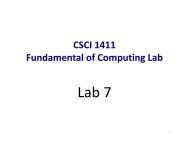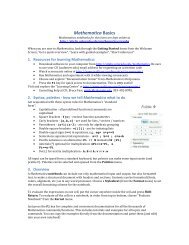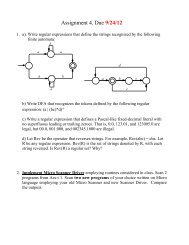[PDF] The Thickness and Chromatic Number of r - Gammeter.com
[PDF] The Thickness and Chromatic Number of r - Gammeter.com
[PDF] The Thickness and Chromatic Number of r - Gammeter.com
Create successful ePaper yourself
Turn your PDF publications into a flip-book with our unique Google optimized e-Paper software.
i = j + k − 1. <strong>The</strong>se <strong>com</strong>bine to tell us that 2k = 1, which is impossible since k is an<br />
integer. In the second case, we have 2r − i + 1 = j + k − 1 <strong>and</strong> i = 2r − j + k, which<br />
<strong>com</strong>bine to tell us that k = 1. Again, this is impossible because we are assuming<br />
Pk �= P1. Thus v2r−i+1vi is not an edge <strong>of</strong> any Pk for k ∈ {2, . . . , r}. A similar<br />
argument shows that v2r−i+2vi is not an edge <strong>of</strong> any Pk, <strong>and</strong> thus paths Pi <strong>and</strong> Pj<br />
are edge-disjoint whenever i �= j.<br />
Finally, by design, the Hamiltonian paths P1, P2, . . . , Pr, each have one endpoint<br />
in {v1, v2, . . . , vr} <strong>and</strong> the other in {vr+1, vr+2, . . . , v2r} <strong>and</strong> every vertex <strong>of</strong> the K2r<br />
is an endpoint <strong>of</strong> a unique Pi.<br />
Notice that in the pro<strong>of</strong> <strong>of</strong> Lemma 1, if we were to replace a vertex vi by its<br />
index i then such an enumeration <strong>of</strong> vertices would provide a graceful labeling <strong>of</strong> P1<br />
modulo 2r. See [Wes01] for the definition <strong>of</strong> graceful labeling.<br />
As mentioned in the introduction to this section, we want our Hamiltonian path<br />
de<strong>com</strong>position <strong>of</strong> K2r to fulfill specific requirements for the endpoints <strong>and</strong> for centermost<br />
edges <strong>of</strong> the paths. To clarify the nature <strong>of</strong> these requirements, we illustrate<br />
P1, P2, <strong>and</strong> P3 for K6 (r = 3).<br />
P1 = v1 v6 v2 v5 v3 v4<br />
P2 = v2 v1 v3 v6 v4 v5<br />
P3 = v3 v2 v4 v1 v5 v6<br />
And for r = 4 we show the edge de<strong>com</strong>position <strong>of</strong> K8 into paths P1, P2, P3, <strong>and</strong> P4.<br />
P1 = v1 v8 v2 v7 v3 v6 v4 v5<br />
P2 = v2 v1 v3 v8 v4 v7 v5 v6<br />
P3 = v3 v2 v4 v1 v5 v8 v6 v7<br />
P4 = v4 v3 v5 v2 v6 v1 v7 v8<br />
In Section 4.2 it will be important to know that the collection <strong>of</strong> edges at the<br />
center <strong>of</strong> each <strong>of</strong> the paths (endpoints shown underlined above) generated in Lemma 1<br />
gives a perfect matching <strong>of</strong> K2r for any r ≥ 2.<br />
Corollary 7. Let paths P1, P2, . . . , Pr be the path de<strong>com</strong>position <strong>of</strong> K2r as constructed<br />
in Lemma 1. A perfect matching for K2r is given by the collection <strong>of</strong> center<br />
edges <strong>of</strong> the paths.<br />
8


![[PDF] The Thickness and Chromatic Number of r - Gammeter.com](https://img.yumpu.com/3978766/8/500x640/pdf-the-thickness-and-chromatic-number-of-r-gammetercom.jpg)





